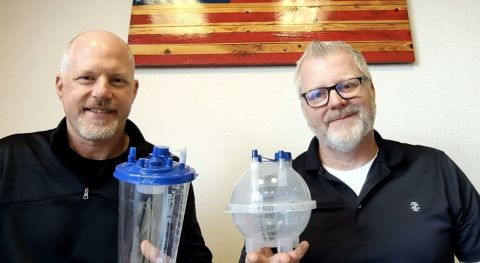Redesigned Medical Canister Could Cut Millions of Pounds of Plastic Waste

Written by Anna Lardinois, Startup Storyteller, November 3, 2025 for MKEStartup.News
When Patrick Tetzlaff describes the spherical canister he and his team developed, he starts with a disclaimer. “This is one of those products where on the surface, it doesn’t look very interesting,” he said. “It’s not flashy. It’s not exciting.”
At first glance, it resembles a standard disposable suction canister used to collect fluids during surgeries and other clinical procedures. These canisters are in nearly every operating room, patient room, and care facility in the country. Their scale, however, is far from ordinary.
According to Practice Greenhealth, a sustainable health care organization, single-use suction canisters account for as much as 25 percent of regulated medical waste produced by hospitals, with some studies indicating that up to 40 percent of surgical regulated waste comes from managing blood and bodily fluids in these containers. A single tertiary care hospital may use 13,000 to 15,000 disposable canisters each year. Across the United States, more than 200 million were used in 2024.
Each canister typically weighs 0.4 pounds when empty, but once filled and disposed of as medical waste, that weight increases to multiple pounds per unit. Depending on how fluids are handled, hospitals may generate anywhere from 9 to 136 tons of canister-related waste each year. For large facilities, this equates to tens to hundreds of thousands of pounds of regulated waste annually.
“It is literally the single largest category of plastic waste contributor in our health care system,” Tetzlaff said. “When you appreciate the scale, the impact of changing this is massive.”
Tetzlaff and his business partner, Brian Leadingham, run Design Department, Inc., a Franklin-based product development consultancy. The firm has worked on medical product innovations for more than a decade. The canister project began when the team realized that small changes applied at scale could have disproportionate impact.
“We always thought there had to be a better way to do it,” he said.
Rethinking the shape
Traditional suction canisters are cylindrical. Tetzlaff explained that a sphere offers important advantages: it can hold the same amount of fluid using less plastic, and the shape distributes pressure more efficiently.
The patented spherical canister uses about half the plastic of the standard design while maintaining the same strength and safety requirements.
“It is one of these rare things where the new version is better in every category you can measure,” Tetzlaff said. “It is stronger. It is safer. It uses less plastic. It ships and stores in a smaller volume. The impact of this at scale is massive.”
Widespread adoption could keep tens of millions of pounds of plastic out of landfills each year.
A key consideration was ensuring that hospitals would not need to change equipment, setup, or protocols. The spherical canister connects to the same ports, tubing, and vacuum systems in use today.
“We did not want to introduce something that required complex retraining or new equipment,” Tetzlaff said. “Everybody is doing this the same way today. So, ours had to be simple too.”
Although the product falls under the FDA’s Class I medical device category, which has relatively low regulatory barriers, market adoption will likely be the more significant challenge.
“Because this is such a commodity, and everybody’s making the same thing, nobody wants to be the first one to change,” he said.
A design-driven mission
The work reflects the firm’s broader philosophy. “What I realized is that we are product people,” Tetzlaff said. “We love solving problems. Not all engineers are wired like that. We enjoy the challenge of asking, if everybody is doing it like this, what if we did it differently?”
Leadingham added, “As product designers, you want to be doing things that are moving the needle and doing good in the industry and in the environment.”
After decades of designing a wide range of products, both founders note that the humble canister may ultimately be the most impactful.
“It is both cool and a little humbling,” Tetzlaff said.
The team will present the spherical canister during the Elevator Pitch Olympics, part of the Early Stage Symposium presented by the Wisconsin Technology Council. The event takes place November 5 and 6 and brings together startups, investors, and business leaders from across the region.
“We just know we have something cool, and we want to connect with the people who can help bring it to market,” Tetzlaff said.
